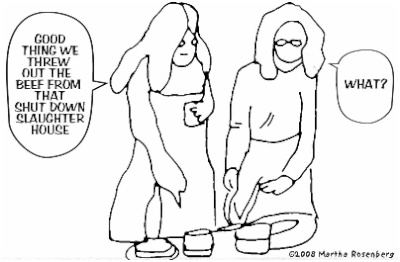Who Drank The Milk From Hallmark/Westland Cows?
Who Drank The Milk From Hallmark/Westland Cows?
The Humane Society's recent slaughterhouse expose www.hsus.org which led to the biggest beef recall in US history was an ethical and hygienic shock to the public.

We're eating WHAT people asked.
But the downer cows viewers saw jabbed in the eyes with herding paddles and forklifted to slaughter were products of the US dairy industry not US beef industry.
An industry so efficient it chews up and spits out cows looking like they do in the video in three to four years.
Especially because from 17% to 33% of the industry still uses Monsanto's rBST.
rBST (recombinant bovine somatotropin) also called rBGH (recombinant bovine growth hormone) was one of the first genetically modified substances approved for US consumption and intended to make dairies more profitable by increasing milk production of individual cow "units."
It was fast tracked through the Food and Drug Administration in 1993 where former Monsanto vice president Michael R. Taylor was in charge of labeling guidelines for rBST and another exMonsanto staffer was in charge of evaluating rBST levels in milk.
And despite a formal Health and Human Services Department investigation requested by Vermont Senators Patrick Leahy and James Jeffords in 1998 and the discovery by Canadian authorities as reported by Reuters that 20-30 percent of rBST tested rats had the drug in their blood stream and some developed cysts and prostate problems, it continues to be an unlabeled agrichemical "perk" in the nation's milk supply.
But the so-called "crack for cows" has some down sides, pun intended.
Because like other factory farming practices, efficiency and harm to human and animal health are inseparable.
While elevating a cow's milk production, it also elevates metabolism, food needs and cull rates.
Some say it even caused or spread mad cow disease when enterprising ranchers took advantage of the last two points and made cows into cannibals.
rBST also causes lameness in cows and udder infections called mastitis which further cull rates and deposit pus and antibiotics in the milk supply.
And rBST is widely suspected of contributing to ballooning rates of US breast and prostate cancer, diabetes, precocious puberty and metabolic disorders.
No wonder Giant Eagle, Kroger, Dean Foods, Borden, Safeway, Publix, Costco, Wal-Mart, Starbucks and Chipotle Mexican Grill are renouncing rBST products.
Even Kraft, the maker of those health foods, Velveeta and Cheez Whiz, is debuting a rBST-free cheese.
Of course some chemofarming friendly states want people to keep drinking the Milk-Aid.
In October, Pennsylvania Agriculture Secretary, Dennis Wolff, announced that 16 dairies who were labeling their milk as "hormone-free" or "antibiotic-free" were guilty of "false or misleading" advertising. But three months later Governor Edward Rendell overruled him because of public outcry.
And Monsanto still bills its product as good for farmers--and even the environment.
"The use of supplemental rBST allows dairy farmers to produce more milk with fewer cows, thereby providing dairy farmers with additional economic security as well as providing related environmental benefits," it says.
But national "omnivore" Michael Pollan says that's cow manure.
"The milk should all come from one Huge Giant Cow," he says if you extend the logic that super efficient cows are better. "That's the argument used for industrial agriculture all the time. And genetically modified food --that maximizing productivity is the best use of resources."
Nor is rBST humane says Pollan. "It leads to a mode of production in which the animals get burnt out very quickly. It's a brutal way to treat animals and to do business."
And how much do rBST farmers make turning cows into the depleted downers seen in the Humane Society video?
An additional $100 a year per cow "unit" says one estimate.
ENDS
Martha Rosenberg, Staff Cartoonist, Evanston Roundtable.


 Gordon Campbell: On Why We Can’t Survive Two More Years Of This
Gordon Campbell: On Why We Can’t Survive Two More Years Of This Binoy Kampmark: Join The Army; Travel To Exotic, Distant Lands; And Radicalise
Binoy Kampmark: Join The Army; Travel To Exotic, Distant Lands; And Radicalise Ramzy Baroud: Letters from Gaza – ‘Alhamdulillah. We Are Not Okay’
Ramzy Baroud: Letters from Gaza – ‘Alhamdulillah. We Are Not Okay’ Ian Powell: Imperialism, Chagos Islanders And The Fight To Return
Ian Powell: Imperialism, Chagos Islanders And The Fight To Return Binoy Kampmark: Frail Egos And Sandpit Colonialism - Australia, The United States And Invading Iraq
Binoy Kampmark: Frail Egos And Sandpit Colonialism - Australia, The United States And Invading Iraq Binoy Kampmark: Ignoring A Leopard’s Spots - The UK, Syria And Courting Dictators
Binoy Kampmark: Ignoring A Leopard’s Spots - The UK, Syria And Courting Dictators